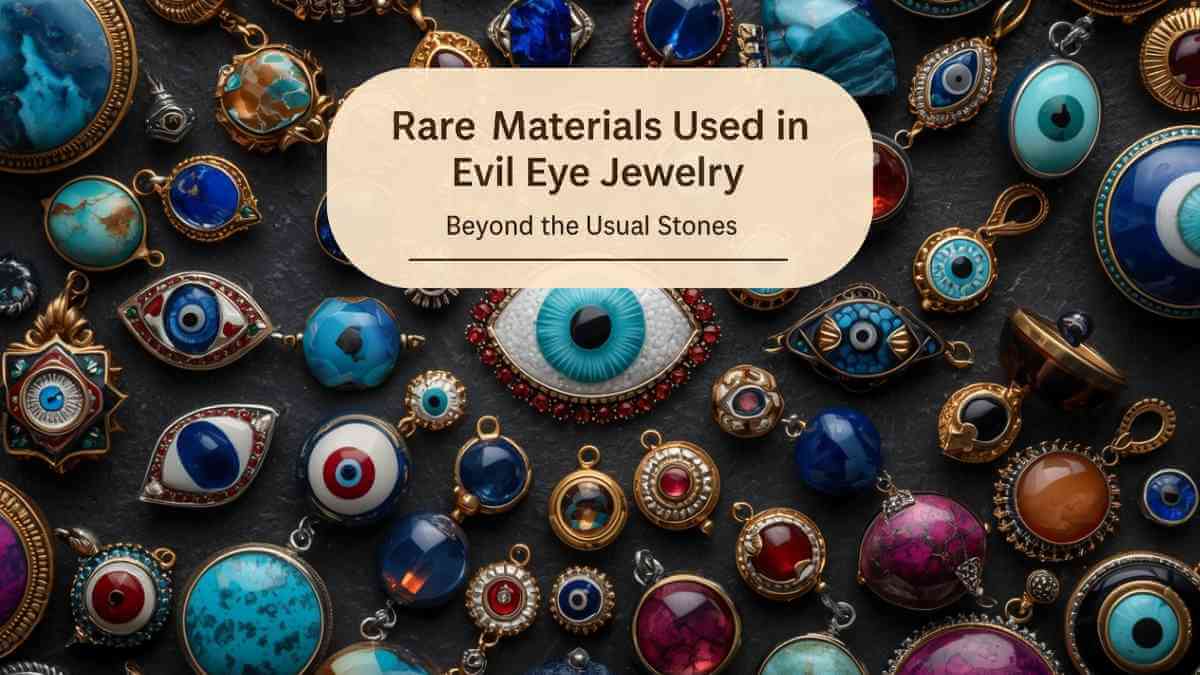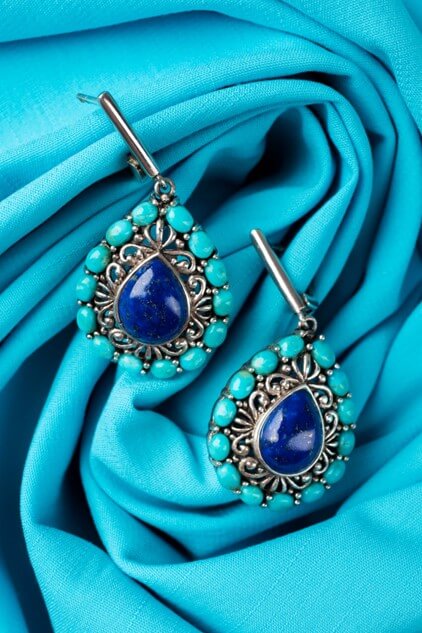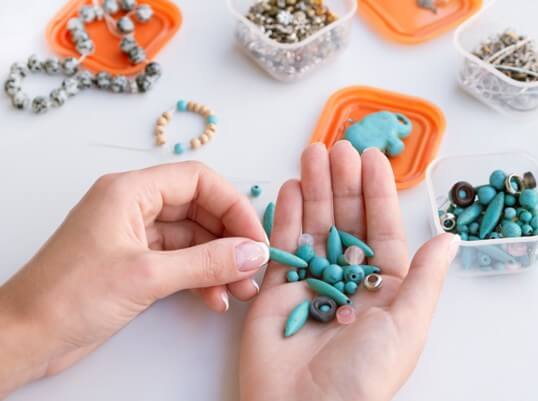Rare Materials Used in Evil Eye Jewelry Today

Most people wear Evil Eye Jewelry for protection. But they rarely ask what it’s made of. That’s the focus of this blog: we’re breaking down the rare Evil Eye Jewelry material used today, and why it matters more than most realize. Some materials are chosen for looks. Others? They carry centuries of meaning. From volcanic glass to obscure metals, each Evil Eye Jewelry material adds weight, value, and intention to the piece.
Historical Use of Materials in Evil Eye Jewelry | How It All Started
Before mass production, before polished displays and branded packaging, Evil Eye Jewelry was raw. Handmade. Sometimes crude. But always intentional.
The earliest Evil Eye Jewelry material wasn’t gold or diamond; it was bone, clay, or bronze. These weren’t chosen for beauty. They were selected for meaning. In Mesopotamia, amulets carved from animal bone were worn to ward off curses. Across the Mediterranean, talismans made of fired clay hung from doorways and necks alike. Each region had its own way of crafting protection.
And while today’s designs lean toward sleek metals and rare stones, the roots haven’t disappeared. Many artisans still incorporate ancient jewelry materials into their work, sometimes blending old with new, and sometimes recreating traditional evil eye pieces with modern tools.
Fact: Bronze was one of the earliest metals used in protective jewelry, valued for its durability and symbolic strength.

Why Rare Materials Are Gaining Popularity | The Shift Toward Meaningful Design
There’s a reason mass-produced charms feel hollow. They’re made to sell, not to speak. That’s why Evil Eye Jewelry material is changing fast.
Buyers are no longer chasing trends. They’re chasing meaning. Rare gemstone jewelry isn’t just about sparkle; it’s about story. A moldavite bead, a shard of larimar, even a sliver of rhodium, each one carries exclusivity, artisanal sourcing, and a sense of personal connection.
In niche jewelry markets, people want more than decoration. They want limited-edition jewelry that feels intentional. That’s why Evil Eye Jewelry material crafted from rare stones and metals, is gaining traction. It’s not just rare, it’s real.
Idea: When a talisman is made from something rare, it feels like it chose you, not the other way around.
Rare Materials Used in Evil Eye Jewelry Today | Beyond the Usual Stones
Most Evil Eye Jewelry looks similar at first glance. But the material? That’s where things shift. Some pieces are made from mass-market glass and plated metal. Others, crafted from rare, meaningful components, feel different the moment you hold them.
These Evil Eye Jewelry materials aren’t just rare. They’re chosen for energy, symbolism, and the stories they carry. Below are the ones that stand out in today’s niche jewelry markets.
Rare Gemstones
These stones aren’t just hard to find; they’re emotionally charged, often tied to transformation, protection, or spiritual clarity. Each one adds depth to the talisman it’s part of.
- Larimar | Found only in one region of the Caribbean, often linked to emotional balance and inner peace
- Moldavite | Formed from meteorite impact, used in spiritual Evil Eye Bracelets for transformation and awakening
- Alexandrite | Changes color under different lighting, symbolizing duality and adaptability
- Black Opal | Deep iridescence, often used in protective talismans for its mysterious energy
- Chrysoberyl Cat’s Eye | Known for its chatoyancy, believed to deflect negative energy
Rare Metals
These aren’t your typical silver or gold. They’re chosen for durability, skin compatibility, and their ability to hold energy without corrosion.
- Niobium | Lightweight, hypoallergenic, and resistant to oxidation
- Rhodium | Often used in plating, it adds shine and protects against wear
- Palladium | Part of the platinum group, valued for its rarity and strength
Organic & Natural Elements
These materials connect the wearer to nature, tradition, and ancestral craftsmanship. They’re often used in tribal or vintage Evil Eye Jewelry designs.
- Operculum Shell | Recognized for its eye-like spiral, historically worn to ward off curses
- Tortoiseshell (vintage only) | Used in antique designs, valued for its layered texture
- Bone & Horn | Common in early talismans, symbolizing strength and primal protection
Fact: Moldavite is one of the few gemstones believed to originate from outer space; its use in Evil Eye Jewelry adds a layer of cosmic symbolism.

Uncommon Metals in Evil Eye Jewelry Settings | Where Strength Meets Symbolism
Not every Evil Eye Jewelry material shines the same way. Some metals are chosen for tradition. Others? For performance. When it comes to rare metals, it’s not just about how they look; it’s about how they behave.
Artisans are turning to rare metals like palladium, rhodium, titanium, and niobium for good reason. These materials offer durability, skin compatibility, and a resistance to corrosion that traditional metals struggle to match. For wearers with sensitive skin or active lifestyles, these choices aren’t a luxury; they’re a necessity.
And yes, each Evil Eye Jewelry material in this category brings something different to the table. Some are lightweight. Some are nearly indestructible. Some hold polish for years without fading. Here’s a quick breakdown:
| Metal | Durability | Skin Safety | Finish Quality | Notes |
| Palladium | High | Excellent | Bright | Part of the platinum group |
| Rhodium | Very High | Excellent | Mirror-like | Used in plating, resists wear |
| Titanium | Extreme | Excellent | Matte/Satin | Lightweight, non-reactive |
| Niobium | High | Excellent | Colorable | Rare, hypoallergenic, stable |
Choosing the right Evil Eye Jewelry material isn’t just about style; it’s about longevity and comfort. And these rare metals deliver both.
Tip: Niobium is often used in aerospace engineering; its stability makes it ideal for jewelry that lasts.
Organic & Natural Materials in Evil Eye Jewelry
Not all Evil Eye Jewelry material comes from metal. Some of the most meaningful pieces are crafted from natural jewelry materials, each with its own story, symbolism, and soul. These organic elements offer a tactile warmth and cultural depth that synthetic options simply can’t replicate.
Ethically sourced and often tied to ancestral traditions, these eco-conscious jewelry choices reflect a growing demand for sustainable materials in spiritual adornment. Here’s a look at some rare organic options used in Evil Eye Jewelry material settings:
- Wood – Symbolizes grounding and growth. Often carved from olive or sandalwood, it connects wearers to nature and heritage.
- Bone – Represents strength and ancestral wisdom. Used in tribal designs, it honors lineage and protection.
- Horn – Associated with resilience and transformation. Ethically harvested horn adds bold texture and primal energy.
- Shell – Evokes intuition and emotional healing. Shell inlays bring oceanic calm and feminine balance.
Each Evil Eye Jewelry material above carries not just aesthetic appeal, but a deeper resonance with the wearer’s values and cultural identity. Choosing organic isn’t just a style, it’s a statement.
Enamel & Glass Techniques in Evil Eye Jewelry
When it comes to expressive Evil Eye Jewelry material, few media rival the vibrancy and depth of enamel jewelry and artisanal glasswork. These techniques transform protective symbols into miniature works of art.
Handcrafted enamel, especially cloisonné, involves outlining designs with fine metal wires and filling them with colored glass powder. Once kiln-fired, the result is a glossy, durable surface that resists fading and wear. Fused glass and lampwork techniques add further dimension, layering molten glass to create intricate evil eye motifs.
Turkish artisans are renowned for their mastery of Evil Eye Jewelry material, particularly in glasswork. Their regional craftsmanship blends centuries-old tradition with modern flair, producing pieces that shimmer with cultural resonance.
Whether it’s the luminous finish of enamel or the depth of fused glass, these techniques elevate Evil Eye Jewelry material from symbolic to spectacular, capturing light, color, and meaning in every detail.
Ceramic & Porcelain in Evil Eye Jewelry
Ceramic and porcelain offer a timeless, earthy touch to Evil Eye Jewelry material, blending ancient craftsmanship with modern design. These ceramic jewelry elements are shaped from fired clay, then glazed and kiln-fired to achieve a smooth, durable finish.
Porcelain beads, known for their delicate sheen and strength, are often hand-painted with evil eye motifs. Their versatility allows for intricate detailing and vibrant color palettes, making them ideal for symbolic pieces.
Artisans favor handcrafted ceramic jewelry for its tactile warmth and cultural resonance. Whether molded into pendants or strung as beads, this Evil Eye Jewelry material offers both resilience and aesthetic flexibility, perfect for wearers seeking meaning beyond metal.
From rustic artisan ceramics to polished porcelain, these materials elevate the evil eye from charm to cherished heirloom.
Rare Combinations | Hybrid Evil Eye Jewelry Materials
Some of the most captivating Evil Eye Jewelry material choices come from unexpected pairings. In hybrid jewelry designs, artisans blend rare elements to create pieces that are both visually striking and symbolically rich.
These multi-material jewelry creations often feature gemstone-metal fusion, combining the spiritual energy of stones with the resilience of metals. Think lapis lazuli set in titanium, or obsidian paired with rhodium-plated silver; each combination amplifies the protective power of the evil eye while adding depth to its aesthetic. Examples of Evil Eye Jewelry material hybrids include:
- Mixed media jewelry with enamel over ceramic bases
- Layered symbolism using horn inlays within gold settings
- Fusion craftsmanship where wood meets palladium for earthy elegance
By merging textures, colors, and cultural references, these Evil Eye Jewelry material combinations offer wearers a truly unique talisman, one that reflects both personal style and spiritual intention. It’s protection, elevated.
Regional Rarity | Materials Unique to Specific Cultures
Some Evil Eye Jewelry material choices are deeply rooted in place, tradition, and identity. These regional jewelry materials carry centuries of meaning, often shaped by the hands of tribal artisans and passed through generations.
- Berber silver – Used in North African ethnic jewelry, this hand-hammered metal symbolizes protection and lineage. Its sourcing is tied to tribal craftsmanship and local mining, making it both rare and culturally rich.
- Himalayan turquoise – Revered for its spiritual energy and healing properties, this stone is a prized Evil Eye Jewelry material in Tibetan and Nepalese traditions. Its vibrant hue and scarcity add to its mystique.
- Baltic amber – Fossilized resin from ancient forests, this warm-toned gem is cherished in Eastern European Evil Eye Jewelry material for its connection to nature and ancestral wisdom.
Due to limited availability and ethical cultural sourcing challenges, these materials elevate the evil eye from ornament to artifact, each piece a wearable story of place and people.
How to Identify Authentic Rare Evil Eye Jewelry Materials
Verifying Evil Eye Jewelry material authenticity requires more than a visual check. Look for certification from recognized gemological or metal testing bodies, especially when rare metals or stones are involved. Genuine pieces often carry an artisan hallmark, a signature, or a stamp indicating origin and craftsmanship.
For authentic jewelry, request documentation detailing material verification, including sourcing and treatment methods. Techniques like XRF material testing can confirm metal purity without damaging the piece.
When purchasing rare Evil Eye Jewelry material, prioritize sellers who emphasize transparency and cultural integrity. Authenticity isn’t just about value; it’s about honoring the story behind the symbol.
Investing in Rare Evil Eye Jewelry Materials
Choosing rare Evil Eye Jewelry material isn’t just a style decision; it’s a jewelry investment in cultural heritage, craftsmanship, and personal meaning. These materials offer long-term value, often becoming cherished collector pieces with deep symbolic worth.
From ethically sourced organics to hybrid fusions and region-specific treasures, each Evil Eye Jewelry material tells a story that transcends trends. As rare jewelry trends continue to evolve, investing in meaningful jewelry ensures your collection reflects authenticity, intention, and timeless appeal. Explore boldly. The most powerful talismans are the ones crafted with care and worn with purpose.
Ready to Choose with Intention?
Rare Evil Eye Jewelry material isn’t just about rarity; it’s about connection. Whether you’re drawn to volcanic glass, bone inlays, or hybrid designs, each piece carries a story worth wearing. Take your time. Explore what speaks to you. And when you’re ready to find a talisman that feels personal, meaningful, and lasting, make sure the material matches the message.



